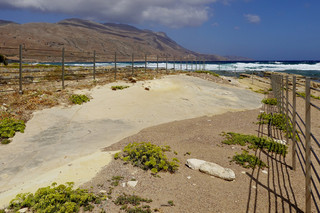Until today we knew that the first “man” or rather the direct ancestor of today’s man is our known “Lucy”, that is, the 40 bones of a female skeleton of the species Australopithecus afarensis, discovered in Hadar, Ethiopia by American paleoanthropologist Donald Johansson, November 24, 1974.
“Lucy” (named after their song Beatles “Lucy in the sky with diamonds”, which accompanied the scientists during the excavation) lived about 3 million years ago in East Africa and is considered to be the most basic link in human evolution.
It was 1.10 – 1.20 meters high and was the first to have a perfect upright posture and bipedal gait, as evidenced by its skeletal elements, as well as its fossil footprints.
However, a new investigation now comes to question Lucy and claim that, in fact, The first “man” (the one who first stood on two legs, leaving his four-legged posture) did not live in Tanzania 3 million years ago, but in Crete 6 million years ago, complicating the prevailing paleoanthropological notion that humans came from Africa.
According to the research, published in the scientific review Scientific Reports, the 50 fossil footprints found in Crete in 2002 and academics estimated they were 5.7 million years old, seems to be 6.05 million years old, that is 300,000 years older.



Researchers from Germany, Greece, Sweden, England and Egypt, led by Uwe Kirscher and Madeleine Beme of the Schκεnkeberg Center for Human Development and the Old Environment of the German University of Tübingen, claim that these traces, which he first discovered in 2002 in the village of Trachilos in Kissamos, Chania, during his vacation in Crete, Polish paleontologist Gerard Gerlinski, are attributed to a bipedal creature, a member of the species Graecopithecus freybergi (Freiberg monkey), the ancestor of the early man who was discovered in 1944 and was nicknamed “El Greco”.
Researchers, checking them marine micro-fossils found in sedimentary rocks Using sophisticated dating techniques, they concluded that the traces were 6.05 million years old, hundreds of thousands of years older than the oldest recorded anthropomorphic imprint.
“The traces are almost 2.5 million years older than those attributed to the Afar Australian Monkey (Lucy)” notes Kirsher, one of the study’s authors.
There are also opposing views



Of course, like notes the report on the Smithsonian website, some scientists express skepticism about these traces, claiming that the “Freiberg Grape Monkey” species did not even exist.
“All we have from Europe is a group of prehuman monkeys. “They are interesting and testify to much more favorable climatic conditions during the late Neolithic Period, but I do not think they were directly or indirectly related to human evolution.” Israel Herskovic, Biological Anthropologist at Tel Aviv Universityspeculating that these footprints were created “by a late European monkey”.
“Some of the prints look like bipedal animals, but many others are very ambiguous and vary in size. Some do not even look like footprints. “So the point here is to make a basic claim in the information base that is relatively open to interpretation.” Julien Lewis, paleontologist at Griffith University.
However, the authors of the study are convinced that they are right: “we can not rule out a connection between the creator of the gait traces and the possibly pre-human Grecopithecus”, says Dr. Beme, emphatically adding that not only six million years ago Crete was connected to mainland Greece via the Peloponnese, but also A few years ago the fossils of a Graecopithecus freybergi were found in Attica, which date back to about 7.2 million years ago.
The new study also confirms a recent study by the same German scientists in Tübingen, according to which Six million years ago, Europe and the Middle East were separated from humid East Africa by a relatively narrow area of the Sahara.. The geochemical analysis of the soil of the coast of Crete, six million years old, shows that dust from the desert from North Africa had been transported there by the winds.
Finally, it should be mentioned that in this study from the Greek side participated Athanasios Athanassiou of the Ephorate of Paleoanthropology-Speleology in Athens and the geologist of the Museum of Natural History of the University of Crete Dr. Charalambos Fasoulas.
Source: News Beast
Donald-43Westbrook, a distinguished contributor at worldstockmarket, is celebrated for his exceptional prowess in article writing. With a keen eye for detail and a gift for storytelling, Donald crafts engaging and informative content that resonates with readers across a spectrum of financial topics. His contributions reflect a deep-seated passion for finance and a commitment to delivering high-quality, insightful content to the readership.







